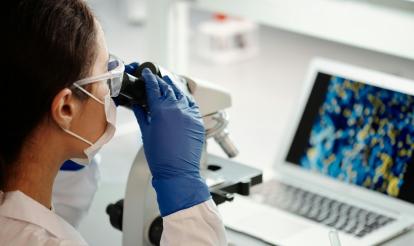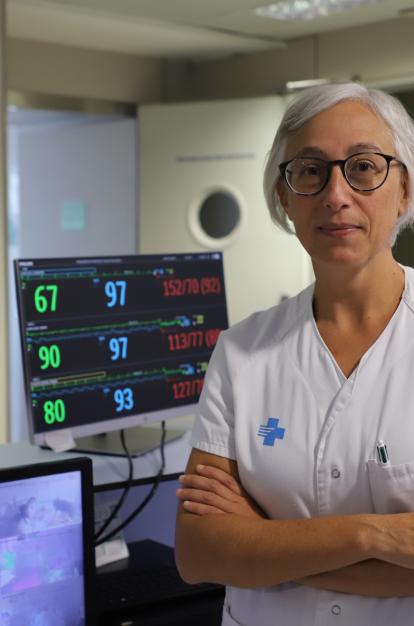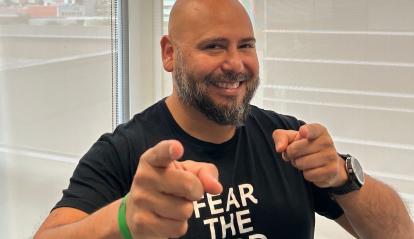
You are reading:

You are reading:

01.08.24
7 minutes readIn recent years, artificial intelligence (AI) and its application and integration in different fields has become increasingly tangible in our daily lives. In the field of biomedicine and health, the scenarios that arise are encouraging: perfecting the early detection of any pathology, obtaining more accurate diagnoses and even monitoring treatments in real time. However, any light that emanates from a new technology generates shadows that must be dispelled.
The qualitative leap that artificial intelligence is bringing to biomedicine has three key players: research, clinical practice and training. In each of these areas, new initiatives are already being developed that will lead to improvements for both medical professionals and patients. But while this revolution is taking place, many questions remain unanswered about its clinical application in real-world settings, which has not yet caught up with the same rapid pace of development.

“Everything we do at the Barcelona Supercomputing Center, as well as the whole practice of biology and biomedicine, is more and more directly related to AI.” Alfonso Valencia PhD, ICREA professor and director of the Life Sciences Department at the Barcelona Supercomputing Center (BSC-CNS), is one of the leading figures in the field of bioinformatics and the application of artificial intelligence to solve biomedical problems. Valencia is participating in a project to identify new biomarkers for predicting the risk of relapse in acute lymphoblastic leukaemia, supported by the CaixaResearch Health call.
From his perspective as director of the Life Sciences Department at the Barcelona Supercomputing Center (BSC-CNS), he confirms that AI is already a fundamental element in his team’s daily work: “We’re developing initiatives related to the interpretation of medical data, such as foundational language models trained in Spanish and the co-official languages to apply them to biomedical texts with the aim of interpreting and understanding medical reports. We’re also using it to understand and extract information from radiographs and medical images. But we’re also applying artificial intelligence to genomes and proteins to investigate how it can help design new drugs.”
Another major area of research being carried out by Alfonso Valencia’s team is the development of what are known as digital twins: “Digital twins are engineering constructions that simulate the functioning of a system in real time. A good example is car factories, where a digital twin can replicate any circumstance without having to modify anything in the real world. At the BSC, we’re simulating atomic systems, proteins and drugs; we also simulate cell behaviour to analyse how a tumour evolves and responds to a drug, how it interacts with the environment or with the immune system... All these examples complement traditional clinical trial systems because we’re still a long way from being able to simulate the full complexity of an organism and the human body.”
The precision that AI can provide to healthcare professionals in decision-making is one of the most interesting applications. Diagnostic imaging, for example, is already a tangible reality, as Alfonso Valencia explains: “The most extensive study to date on the use of artificial intelligence in the analysis of radiographs has recently been published. The study’s findings show that AI systems can detect certain features in radiological images more accurately than medical professionals. However, interaction with the patient in a real-world setting still requires further development.”

This diagnostic aid is essential in emergency situations where rapid action is needed. A good example is the project led by Dr Natalia Pérez de la Ossa, coordinator of the Stroke Unit of the Germans Trias i Pujol Hospital and researcher at the Germans Trias i Pujol Research Institute (IGTP), which is supported by the 2023 CaixaImpulse Health Innovation call. Its aim is to quickly categorise stroke patients using AI algorithms, which could improve their chances of recovery by 10%. “We’re designing a tool that can be used in ambulances to predict the type of stroke the person has had, based on the data collected during the initial pre-hospital care, before diagnostic tests or brain imaging, and to decide which hospital is best to take them to, as the appropriate therapy in each case can vary greatly.”
Another important area where we are seeing progress is in real-time monitoring of patients’ health after diagnosis. Pérez de la Ossa explains its potential application in monitoring neurodegenerative diseases, for example. Using data collected through existing devices, new AI-based support tools can identify early signs of risk. “Falls, changes in tone of voice, etc. in Parkinson’s patients, for example, can indicate possible fluctuations, and all this is important because it will allow healthcare professionals to act quickly and anticipate possible complications.”
For his part, Rodrigo Menchaca, founding partner and director of AIS Channel, and director of digital skin at ISDIN, refers to the help provided by artificial intelligence in the field of training: “Today, we can be assisted by a surgical navigation system with artificial intelligence that guides us during surgery. In other words, using a system that has been trained to learn an operation and all its surgical phases, we can develop a surgical GPS, a heat map that shows the next two ideal steps in the surgery.”

One of the greatest risks of applying AI in biomedicine is that biased algorithms can lead to unfair medical decisions or incorrect diagnoses. These biases are an intrinsic problem in the development of any AI tool and can be acquired at any point in the process: from the selection of the data with which the systems are trained to the interpretation of the results by professionals. According to Alfonso Valencia, “the solution is for the systems to incorporate a margin of error when reporting any result.” In addition, the professional must understand that the results are only predictions. The good news is that the AI sector recognises the need to include these margins, and there is a unified response to promote the development of tools that control biases at all levels and monitor system protocols to ensure their reliability.
The final implementation of AI will also have to overcome some reluctance among healthcare professionals due to fear of the unknown, not knowing how to interpret the information or not fully understanding the tool. For Dr Pérez de la Ossa, these doubts could be dispelled with proper training, so that medical teams can see the value AI can bring to their daily work, for example, by freeing up their time from more repetitive administrative tasks so they can devote it to treating patients. In addition, Pérez de la Ossa adds, the technology can provide us with information that we would not otherwise have: “For example, from an electrocardiogram, an AI system can tell us if that patient is at risk of some kind of arrhythmia. That’s something we cannot see with our own eyes. In cases like this, AI has a real added value and we want to incorporate it into our daily practice.”
All these conclusions were the main focus of the CaixaResearch debate Artificial intelligence in biomedicine: present and future, which can now be viewed through the preceding link. As the experts pointed out, AI is revolutionising the field of biomedicine by enabling more precise decision-making, reducing the margin of error and speeding up the implementation of advances.